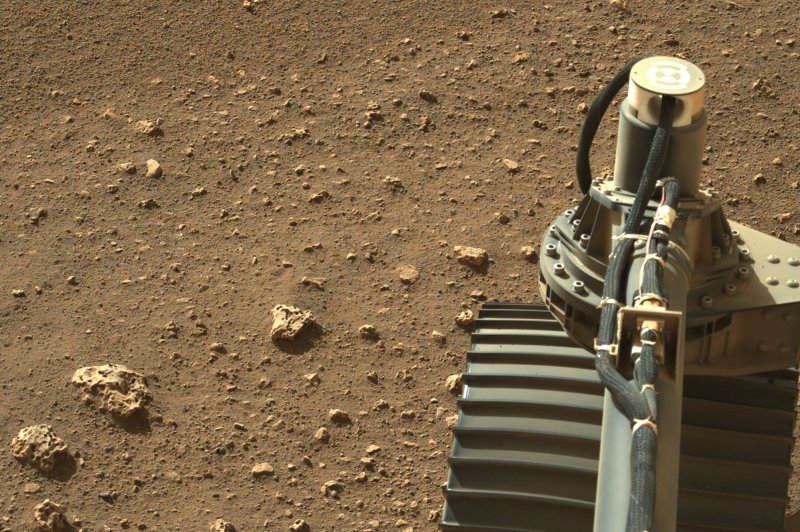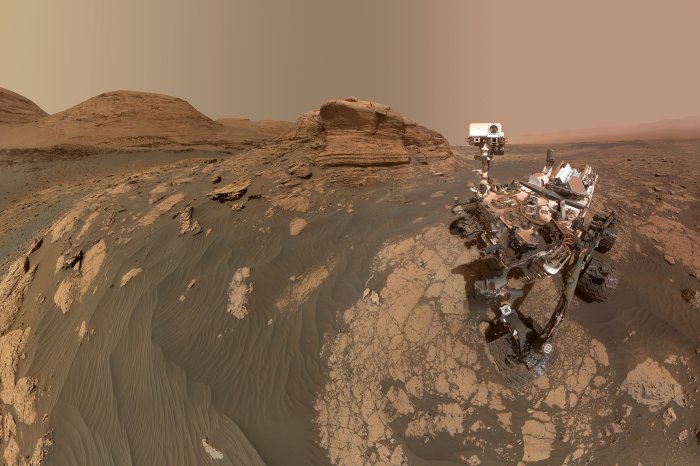
1/4
NASA's Mars Perseverance rover snapped this photo on the surface of the Red Planet on February 24, 2021. Scientists said this week that the marsquake registered a magnitude of 5.0.
File Photo by NASA/UPI | License Photo
May 11 (UPI) -- NASA's state-of-the-art equipment that's sitting on the surface of Mars has detected the most powerful earthquake ever recorded on the Red Planet -- or any other world away from the Earth, for that matter.
Scientists at NASA's Jet Propulsion Laboratory in California said that the InSight Mars lander measured the "monster" marsquake -- which was a 5.0-magnitude temblor.
The InSight lander, which has been on Mars since late 2018, has a highly sensitive seismometer to study the deep interior of the planet. The previous record-holder was a 4.2-magnitude quake that occurred last August.
Scientists said that the new strong quake was measured on May 4 -- 1,222 Martian days, or sols, since the lander has been there.
"Since we set our seismometer in December 2018, we've been waiting for 'the big one,'" Bruce Banerdt, InSight principal investigator at JPL, said in a statement.

NASA's InSight Mars Lander captured this image not long after it landed on the Red Planet on November 26, 2018. Equipment on the lander measured the 5.0-magnitude quake on May 4. File Photo by NASA/UPI
"This quake is sure to provide a view into the planet like no other. Scientists will be analyzing this data to learn new things about Mars for years to come."
As seismic waves pass through or reflect off material in Mars' crust, mantle and core, they change in ways that seismologists can study to determine the depth and composition of those layers, scientists said.
"What scientists learn about the structure of Mars can help them better understand the formation of all rocky worlds, including Earth and its Moon," NASA said in a statement.
"The science team will need to study this new quake further before being able to provide details such as its location, the nature of its source, and what it might tell us about the interior of Mars.
The InSight lander is part of NASA's Discovery program, which is exploring detailed facts about the Red Planet.
May 11 (UPI) -- NASA's state-of-the-art equipment that's sitting on the surface of Mars has detected the most powerful earthquake ever recorded on the Red Planet -- or any other world away from the Earth, for that matter.
Scientists at NASA's Jet Propulsion Laboratory in California said that the InSight Mars lander measured the "monster" marsquake -- which was a 5.0-magnitude temblor.
The InSight lander, which has been on Mars since late 2018, has a highly sensitive seismometer to study the deep interior of the planet. The previous record-holder was a 4.2-magnitude quake that occurred last August.
Scientists said that the new strong quake was measured on May 4 -- 1,222 Martian days, or sols, since the lander has been there.
"Since we set our seismometer in December 2018, we've been waiting for 'the big one,'" Bruce Banerdt, InSight principal investigator at JPL, said in a statement.

NASA's InSight Mars Lander captured this image not long after it landed on the Red Planet on November 26, 2018. Equipment on the lander measured the 5.0-magnitude quake on May 4. File Photo by NASA/UPI
"This quake is sure to provide a view into the planet like no other. Scientists will be analyzing this data to learn new things about Mars for years to come."
As seismic waves pass through or reflect off material in Mars' crust, mantle and core, they change in ways that seismologists can study to determine the depth and composition of those layers, scientists said.
"What scientists learn about the structure of Mars can help them better understand the formation of all rocky worlds, including Earth and its Moon," NASA said in a statement.
"The science team will need to study this new quake further before being able to provide details such as its location, the nature of its source, and what it might tell us about the interior of Mars.
The InSight lander is part of NASA's Discovery program, which is exploring detailed facts about the Red Planet.
Chinese rover detects water existed on Mars more recently than thought

Scientists used instruments to analyze rocks and minerals on the surface of Mars,

Scientists used instruments to analyze rocks and minerals on the surface of Mars,
finding evidence there was substantial liquid water on the planet more recently
than previously thought.
Photo courtesy of the China National Space Administration
May 11 (UPI) -- Nearly one year after landing on Mars, scientists say China's Zhurong rover collected data indicating water may have existed on the planet over a longer period of time than previously thought.
A study published Wednesday in the journal Science Advances said Zhurong detected evidence that the Utopia Planitia basin had "substantial" liquid water during its most recent epoch of geologic history -- the Amazonian. Scientists previously believed this time period, about 700 million years ago, to be cold and dry and liquid water activities to be "extremely limited."
Before assessing the new data, scientists believed that Mars lost much of its water after its Hesperian period, about 3 billion years ago.
The Zhurong rover touched down on Mars' surface May 15 as part of the Tianwen-1 mission. The main point of the mission was to search for signs of life, ice and water.
Scientists from China's National Space Science Center and the Chinese Academy of Sciences analyzed data gathered from a laser-induced breakdown spectrometer, telescopic microimaging camera and short-wave infrared spectrometer to study minerals to determine the amount of liquid water that would have been at the site millions of years ago.
May 11 (UPI) -- Nearly one year after landing on Mars, scientists say China's Zhurong rover collected data indicating water may have existed on the planet over a longer period of time than previously thought.
A study published Wednesday in the journal Science Advances said Zhurong detected evidence that the Utopia Planitia basin had "substantial" liquid water during its most recent epoch of geologic history -- the Amazonian. Scientists previously believed this time period, about 700 million years ago, to be cold and dry and liquid water activities to be "extremely limited."
Before assessing the new data, scientists believed that Mars lost much of its water after its Hesperian period, about 3 billion years ago.
The Zhurong rover touched down on Mars' surface May 15 as part of the Tianwen-1 mission. The main point of the mission was to search for signs of life, ice and water.
Scientists from China's National Space Science Center and the Chinese Academy of Sciences analyzed data gathered from a laser-induced breakdown spectrometer, telescopic microimaging camera and short-wave infrared spectrometer to study minerals to determine the amount of liquid water that would have been at the site millions of years ago.
NASA’s Curiosity Mars rover used two different cameras to create this panoramic selfie, comprised of 60 images, in front of Mont Mercou, a rock outcrop that stands 20 feet tall on March 26, 2021, the 3,070th Martian day, or sol, of the mission. These were combined with 11 images taken by the Mastcam on the mast, or "head," of the rover on March 16. The hole visible to the left of the rover is where its robotic drill sampled a rock nicknamed "Nontron." The Curiosity team is nicknaming features in this part of Mars using names from the region around the village of Nontron in southwestern France.
Photo courtesy of NASA/JPL-Caltech/MSSS

No comments:
Post a Comment